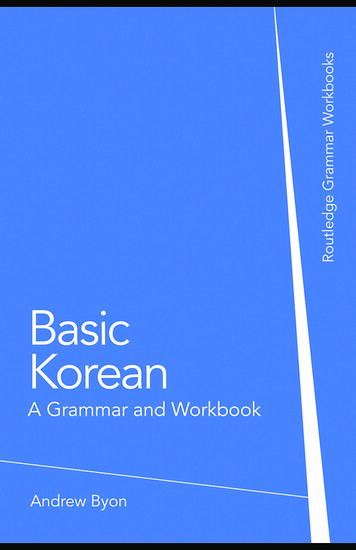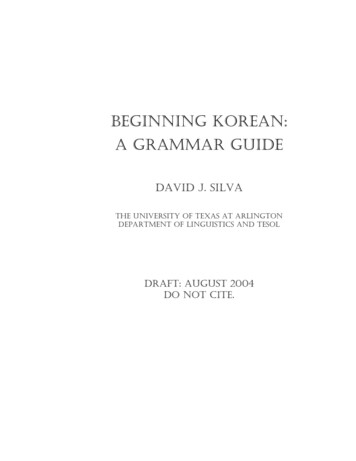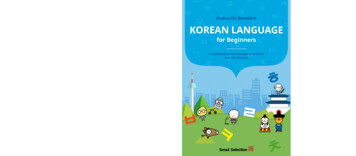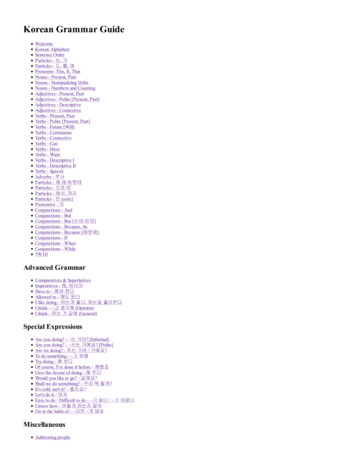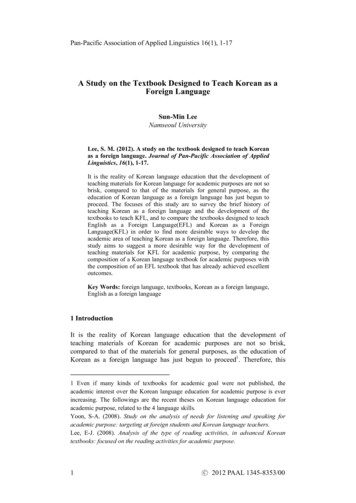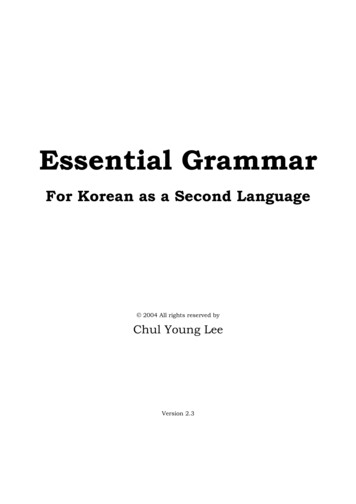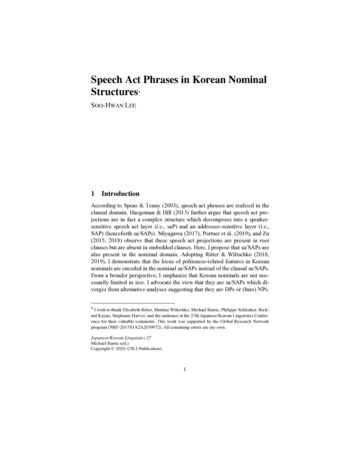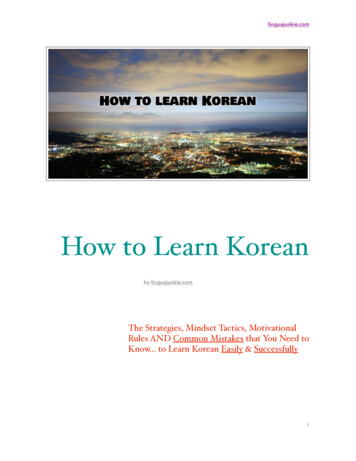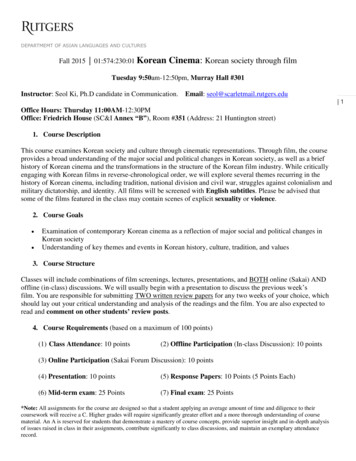
Transcription
DEPARTMEMT OF ASIAN LANGUAGES AND CULTURESFall 2015 01:574:230:01 KoreanCinema: Korean society through filmTuesday 9:50am-12:50pm, Murray Hall #301Instructor: Seol Ki, Ph.D candidate in Communication.Email: seol@scarletmail.rutgers.eduOffice Hours: Thursday 11:00AM-12:30PMOffice: Friedrich House (SC&I Annex “B”), Room #351 (Address: 21 Huntington street)1. Course DescriptionThis course examines Korean society and culture through cinematic representations. Through film, the courseprovides a broad understanding of the major social and political changes in Korean society, as well as a briefhistory of Korean cinema and the transformations in the structure of the Korean film industry. While criticallyengaging with Korean films in reverse-chronological order, we will explore several themes recurring in thehistory of Korean cinema, including tradition, national division and civil war, struggles against colonialism andmilitary dictatorship, and identity. All films will be screened with English subtitles. Please be advised thatsome of the films featured in the class may contain scenes of explicit sexuality or violence.2. Course Goals Examination of contemporary Korean cinema as a reflection of major social and political changes inKorean societyUnderstanding of key themes and events in Korean history, culture, tradition, and values3. Course StructureClasses will include combinations of film screenings, lectures, presentations, and BOTH online (Sakai) ANDoffline (in-class) discussions. We will usually begin with a presentation to discuss the previous week’sfilm. You are responsible for submitting TWO written review papers for any two weeks of your choice, whichshould lay out your critical understanding and analysis of the readings and the film. You are also expected toread and comment on other students’ review posts.4. Course Requirements (based on a maximum of 100 points)(1) Class Attendance: 10 points(2) Offline Participation (In-class Discussion): 10 points(3) Online Participation (Sakai Forum Discussion): 10 points(4) Presentation: 10 points(5) Response Papers: 10 Points (5 Points Each)(6) Mid-term exam: 25 Points(7) Final exam: 25 Points*Note: All assignments for the course are designed so that a student applying an average amount of time and diligence to theircoursework will receive a C. Higher grades will require significantly greater effort and a more thorough understanding of coursematerial. An A is reserved for students that demonstrate a mastery of course concepts, provide superior insight and in-depth analysisof issues raised in class in their assignments, contribute significantly to class discussions, and maintain an exemplary attendancerecord. 1
DEPARTMEMT OF ASIAN LANGUAGES AND CULTURES4. Course Requirements (Cont’d)(1) Attendance (10 points)Attendance (both lectures & screenings) is MANDATORY. You are also expected to have read and thoughtcarefully about the required readings before each class, so that you can fully engage in class discussions.(2) Response papers (2 papers * 5 points 10 points)Each student should choose 2 films (among 12 films to be screened in class) and write a critical review paper.Students need to watch the film in class and (1) write a response paper and post it to Sakai discussion forumby Friday 11:59PM. The paper should address specific comments and questions about the film (e.g., cultural,social, political, historic issues) portrayed in the film. Your response paper should reflect your familiarity withthe film and the reading material, but should GO BEYOND merely summarizing them.Your task is NOT to simply describe or review the film but rather to REACT to it. Respond to some of theissues in the film that interest, intrigue, awe, baffle, or trouble you most. Your essay should consider both (a)what the film reveals about Korean society and (b) your own affective response to the movie - what it made youfeel and why. As the semester progresses and we have done more and more viewing and reading together, it islikely that your response to any single film will be made in relation to other previous films, readings,classmates’ posts, and/or classroom discussions.Format: 1” margins, 12pt Times New Roman font, Single spaced, 1-3 pages (minimum 500 - max 1,500words)Your response paper should include (1) detailed analysis (e.g., what you thought of the film in terms of themes,societal, ideological implications, drawing linkages between ideas, posing questions or comments that come toyour mind when you watch the film and read the assigned articles, making connection with other films orreadings., 50% of your paper), (2) criticism (what you liked and disliked, how you felt and why , 30% ofyour paper), and (3) conclusion (20% of your paper). You are also required to post the response papers to Sakaidiscussion forum by Friday midnight. Late submission will be penalized without any exceptions.(3) Participation (20 points Sakai online participation 10 points offline class discussion 10 points)Each class, the quality and the quantity of your participation (both online & offline) will be counted. You arenot only responsible for writing your own response papers, but also for reading the online posts made by yourclassmates. The collective posts will be good resources for your learning progress.Each student should choose 5 films (among 12 films to be screened in class) for online discussion participation.Once students upload response papers to Sakai forum by Friday midnight, students should read each post andreply to at least ONE of the posts two days before class meeting (Sunday, 11:59pm). You have to replythoughtfully to the response posts made by other students on Sakai forum. The reply should exceed at least200 words. Copy & paste (direct quotes) from other student’s original review post or the reading materials areNOT allowed.*Posting more than one reply may boost your participation grade for shy students who are quiet in class.**If there is no original post made by other students, you don’t have to leave a reply for the week. 2
DEPARTMEMT OF ASIAN LANGUAGES AND CULTURES4. Course Requirements (Cont’d)(4) Group Presentation (10 points)Choose one of the films referring to our syllabus. You will be assigned to a group for your power point 3presentation. Then research (either individually or with a partner) to (a) present basic information about the filmand the filmmaker in a couple of minute presentation (20% of your presentation grade) and (b) lead thediscussion in-class for 15-20 minutes (pose questions or challenges to the class that will help enliven thediscussion, 80% of your presentation grade). Feel free to make the class presentation as enjoyable as you can.All students should sign up for the presentation by Week 2.(5) Two exams (50 points/ midterm: 25pts; final: 25pts)There will be two exams throughout the semester to make sure students complete the assigned readings andunderstand the key concepts and terms discussed in class. The exams will consist of multiple choices, fill in theblank, and short answer/essay questions. Exams are NOT cumulative: each exam will test the materialscovered PRIOR to the exam day. There is NO make-up exam. If you miss the exam, you will get zeroautomatically.5. Course Policy Plagiarism: All written work should be composed in the student’s own words and the ideas of othersshould be properly cited. It is the responsibility of all students to know and adhere to the university’spolicy on plagiarism. Violations include: cheating, fabrication, and facilitating violations of academicintegrity. These are serious violations that could lead to an F in the course and/or expulsion fromthe university. If there are any questions concerning this policy or about documentation of sources forwork in the course, ask rather than inadvertently violating the policy. Assignments: All reading and written assignments are required and should be done before class. Lateassignments will be deducted a full letter grade for each late day (i.e. A to a B, B to a C ). If thereare emergencies, medical or otherwise, it is the student’s responsibility to contact the instructor as soonas possible to make appropriate arrangements. Attendance: Regular class attendance is mandatory, especially for a class that meets only once aweek. In order to succeed in this course, students are expected to attend every class. Avoid arriving lateor leaving early since this disrupts the class. If you miss more than 3 classes, you will be officiallydropped out of class. Any late submission of class work will result in 10% reduction per day after thedue date.More than 2 absences may lead to a deduction of a full letter grade for the course, and 4 absenceswill lead to an F; 2 late days will be treated as an absence. There will be 12 screenings and 13discussion sessions. It is in your interest to be on time as important announcements regardingassignments and exams are made in the first five minutes of class.If you expect to miss one or two classes, please use the University absence reportingwebsite https://sims.rutgers.edu/ssra/ to indicate the date and reason for your absence. An email isautomatically sent to me.
DEPARTMEMT OF ASIAN LANGUAGES AND CULTURES Gadgets: All communication devices must be turned off for the duration of the class, and laptops arenot allowed. Your participation grade may go down 1 point every time you use your cell phone. Conduct: Complete your reading before class. Be alert in class, and take notes. The instructor willNOT give you any lecture notes/ class slides. Class lectures and discussions will be covered inexams. Please do not disrupt the class by coming and going at will. Emails: Instructors receive a lot of emails each day. They may not be able to respond to your email rightaway. Send your email well in advance. Do not wait until the last minute. Disabilities: Students with disabilities who are seeking consideration for services or accommodationsshould immediately contact the Office of Disability Services at (732) 932-2848, 151 College Ave. Fulldisability policies and procedures are at http://disabilityservices.rutgers.edu This syllabus may be modified throughout the semester, and it is the responsibility of each student tokeep up to date of any and all announcements made in class.6. Text: There is no required text book. All reading materials are uploaded on Sakai-Resources folder.7. Additional Resources (Do not plagiarize – Copy & paste from these websites are not allowed) Books about Korean Cinemahttp://www.koreanfilm.org/books.htmlDarcy Paquet’s Website on Korean Cinemahttp://www.koreanfilm.orgPierce Conran’s Blog on ttp://www.hancinema.net/25 Best Korean New Wave Films s-of-the-south-korean-new-wave/8. Class Schedule*Weekly readings are posted on Sakai.#9/ 1Topic#1 IntroductionScreening: Old Boy (Park, Chanwook/ 2003, 120 min.)9/89/15No class- Rutgers follows Monday schedule#2 Hallyu: The Korean Wave(1) Kyung Hyun Kim (2006)9/22Discussion: Old BoyScreening: The Host (Bong, Joon-ho/ 2006, 119 min.)#3 Korean Blockbuster(2) Darcy Paquet (2009) Ch.4 &Conclusion: pp.92-115Christina Klein (2008)Discussion: The HostScreening: Castaway on the Moon (Lee, Hye-joon/ 2009, 116min.)Reading DueSyllabus overview 4
DEPARTMEMT OF ASIAN LANGUAGES AND CULTURES9/29#4 Anomie in Korean society 1David Ross (2012)Discussion: Castaway on the MoonScreening: Hahaha (Hong, Sang-Soo, 2010, 115 min.)10/6#5 Anomie in Korean society 2Michelle Cho (2015)Discussion: HahahaScreening: The Good, the Bad, the Weird (Kim, Jee-woon/ 2008)10/13 #6 ’Awkward’ Aesthetics: Hong, Sang-sooDavid Scott Diffrient (2014)Discussion: The Good, the Bad, the WeirdScreening: Spring, Summer, Fall, Winter and Spring (Kim,Ki-duk/ 2003, 106 min.)10/20 #7 ’Extreme’ Aesthetics: Kim, Ki-dukHye Seung Chung (2010)Discussion: Spring, Summer, Fall, Winter and SpringScreening: Marathon (Jeong, Yun-cheol/ 2005, 115 min.)10/2711/3Midterm#8 Minority in Korean SocietyChungWan Woo (2014)Discussion: MarathonScreening: Peppermint Candy (Lee, Chang-dong/ 1999, 127 min.)11/10 #9 Road to Liberty and JusticeAaron HJ Magnan-Park (2005)Discussion: Peppermint CandyScreening: Joint Security Area (Park, Chanwook/ 2000, 110 min.)11/17 #10 Meaning of Brotherhood in a Divided NationSuk-Young Kim (2007)Discussion: JSAScreening: Welcome to Dongmakgol (Pak, KwangHyon/ 2005,133 min.)11/24 #11 Korean War: Revisiting Historical TraumaJake Bevan (2010)Discussion: Welcome to DongmakgolScreening: Chihwaseon (Im, Kwon-taek/ 2002, 120 min.)12/1#12 Historical Backdrop to the Korean CinemaDiscussion: ChihwaseonScreening: King and the Clown (Lee, Joon-ik/ 2005, 119 min.)Davis James (2006) 5
DEPARTMEMT OF ASIAN LANGUAGES AND CULTURES12/8#13 Traditional Korean SocietyJeeYoung Shin (2013)Discussion: King and the ClownWrap up, Q&A12/22Final Exam: Tuesday, Dec 22, 8:00AM - 11:00AMFull Reading List (Alphabetized, Download them from Sakai ‘resources’ folder) Aaron Han Joon Magnan-Park, "Peppermint Candy: The Will Not To Forget." in New Korean Cinema.eds. Chi-Yun Shin & Julian Stringer, (NYU Press, 2005): 159-169.Christina Klein, “Why American Studies Needs to Think about Korean Cinema, or, TransnationalGenres in the Films of Bong Joon-ho,” American Quarterly 60, no. 4 (December 2008): 871-898.ChungWan Woo, "Disability as a Political Stand-In and Shield," The Journal of Special Education:Theory and Practice 15, no 4 (December 2014), 365-396.Darcy Paquet, New Korean Cinema: Breaking the Waves (Wallflower Press, 2009): 92-115.Davis James, “Art/film/art film: Chihwaseon and its cinematic contexts.” Film Quarterly 59, no. 2(January 2006): 4-17.David Ross, "This Island Asia: The Crusonian Theme in Asian Films," Southeast Review of AsianStudies 34 (2012):186-195.David Scott Diffrient, “The unbearable lightness of Hong Sangsoo's HaHaHa: awkward humor, nervouslaughter, and self-critique in contemporary Korean comedy,” New Review of Film and TelevisionStudies 12, no.1 (2014): 37-59.Hye Seung Chung. "Beyond Extreme: Rereading Kim Ki-duk's Cinema of Ressentiment." Journal ofFilm and Video 62, No.1 (2010): 96-111.Jake Bevan, "Welcome to Panmunjeom: encounters with the north in contemporary South Koreancinema," New Cinemas: Journal of Contemporary Film 8, no. 1 (August 2010): 45-57.Jeeyoung Shin, "Male Homosexuality in The King and the Clown: Hybrid Construction and ContestedMeanings." Journal of Korean Studies 18, no1 (2013): 89-114.Kyung Hyun Kim, “Tell the Kitchen that There’s Too Much Buchu in the Dumpling”: Reading ParkChan-wook’s “Unknowable” Old Boy,” Korea Journal 46, no. 1 (Spring 2006): 84-108.Michelle Cho, "Genre, Translation, and Transnational Cinema: Kim Jee-woon's The Good, the Bad, theWeird." Cinema Journal 54, no. 3 (2015): 44-68.Suk-Young Kim, “Crossing the Border to the Other Side: Dynamics of Interaction between North andSouth Korean in Spy Li-Cheol-jin and Joint Security Area,” in Seoul Searching: Contemporary KoreanCinema and Society, eds. Frances Gateward, (SUNY Press, 2007): 219-242. 6
DEPARTMEMT OF ASIAN LANGUAGES AND CULTURES 1 Fall 2015 01:574:230:01 Korean Cinema: Korean society through film Tuesday 9:50am-12:50pm, Murray Hall #301 Instructor: Seol Ki, Ph.D candidate in Communication. Email: seol@scarletmail.rutgers.edu Office Hours: Thursday 11:00AM-12:30PM Office: Friedrich House (SC&am



